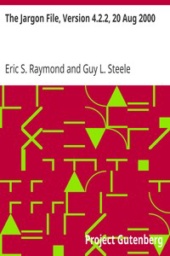

The Jargon File, Version 4.2.2, 20 Aug 2000 (2000)
by Eric S. Raymond, Guy L. Steele


There are some standard methods of jargonification that became established quite early (i.e., before 1970), spreading from such sources as the Tech Model Railroad Club, the PDP-1 SPACEWAR hackers, and John McCarthy's original crew of LISPers. These include verb doubling, soundalike slang, the `-P' convention, overgeneralization, spoken inarticulations, and anthropomorphization. Each is discussed below. We also cover the standard comparatives for design quality.⏎ Of these six, verb doubling, overgeneralization, anthropomorphization, and (especially) spoken inarticulations have become quite general; but soundalike slang is still largely confined to MIT and other large universities, and the `-P' convention is found only where LISPers flourish.⏎ Verb Doubling: Doubling a verb may change its semantics⏎ Soundalike Slang: Punning jargon⏎ The -P convention: A LISPy way to form questions⏎ Overgeneralization: Standard abuses of grammar⏎ Spoken Inarticulations: Sighing and <*sigh*>ing⏎ Anthropomorphization: Homunculi, daemons, and confused programs⏎ Comparatives: Standard comparatives for design quality🏁
Global Leaderboard
| # | Player | Time | Duration | Accuracy | WPM | pp | |
|---|---|---|---|---|---|---|---|
| 1 | |||||||
| 2 | |||||||
| 3 | |||||||
| 4 | |||||||
| 5 | |||||||
| 6 | |||||||
| 7 | |||||||
| 8 | |||||||
| 9 | |||||||
| 10 |


There are some standard methods of jargonification that became established quite early (i.e., before 1970), spreading from such sources as the Tech Model Railroad Club, the PDP-1 SPACEWAR hackers, and John McCarthy's original crew of LISPers. These include verb doubling, soundalike slang, the `-P' convention, overgeneralization, spoken inarticulations, and anthropomorphization. Each is discussed below. We also cover the standard comparatives for design quality.⏎ Of these six, verb doubling, overgeneralization, anthropomorphization, and (especially) spoken inarticulations have become quite general; but soundalike slang is still largely confined to MIT and other large universities, and the `-P' convention is found only where LISPers flourish.⏎ Verb Doubling: Doubling a verb may change its semantics⏎ Soundalike Slang: Punning jargon⏎ The -P convention: A LISPy way to form questions⏎ Overgeneralization: Standard abuses of grammar⏎ Spoken Inarticulations: Sighing and <*sigh*>ing⏎ Anthropomorphization: Homunculi, daemons, and confused programs⏎ Comparatives: Standard comparatives for design quality🏁